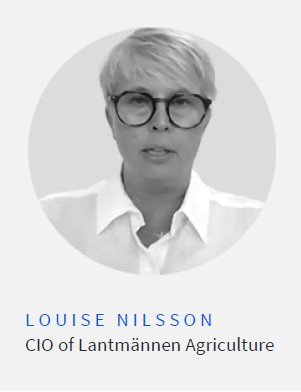Unlocking the benefits of a cloud upgrade
Exploring why now is the time to make the move with the CIO of Lantmännen Agriculture
Lantmännen is an agricultural cooperative and Northern Europe’s leader in agriculture, machinery, bioenergy, and food products. Owned by 19,000 Swedish farmers, Lantmännen has 10,000 employees, operations in over 20 countries, and an annual turnover of SEK 45 billion (approx. $5.5B). With grain at the heart of the operations, it refines arable land resources to make farming thrive.
We recently teamed up with Louise Nilsson, CIO of Lantmännen Agriculture sector, to hear why the company decided to upgrade its on-premises ERP system to the multi-tenant cloud. Here’s what she had to say.
What’s your history with Infor and M3?
We have a long history with Infor. We’ve used Infor M3® (and Movex previously) as our business platform for more
than 20 years. We’ve upgraded the solution repeatedly and a couple of years ago, when we acquired two Finnish companies, we integrated them into Lantmännen Agriculture and our M3 business platform.
What are some the drivers in your industry that you are responding to?
We’re in a fast-changing business. Farmers may be seen as traditional, yet they are not. In the coming years we’ll need to support the next generation of farmers with new requirements and there will also be bigger farms. For us, it means that we need to move faster and be more flexible to meet those requirements. We can’t do that on an old business platform. We need to modernize and get the continuous updates that come with the multi-tenant cloud.
What’s your current IT landscape today?
Lantmännen Agriculture consists of three companies; we have the agriculture sector in Sweden running on M3 10.1, the Finnish agriculture sector that recently implemented M3 13.4 on premises, and the machinery sector, which is in the middle of a project to upgrade from M3 5.2 to the multi-tenant cloud. Going from a heavily modified M3 5.2 version to a more standardized version in the cloud is a huge step for the machinery business.
Why did your organization decide to go to MT cloud? And why now?
I’d say that there’s no reason not to go to the MT cloud. We need to be able to adapt quickly to all the changes we see coming, which means we need to have a business platform that allows us to move fast and stay current. We don’t want to disrupt the business with big, costly, and time-consuming upgrades every
5-10 years. I think there’s really no option not to go to the cloud to get your business in a better position faster.
the cloud when it comes to business, IT, and transformation ambitions?
From a business point of view, they shouldn’t care whether they use an ERP package that’s in the cloud or on-premises. It’s not their responsibility. But from an IT perspective, it’s a huge change. We have a new technology that we need to understand; we also must be prepared for the monthly updates, which means constant testing, improving the way we do our test scripts, and automating it all, which is all fairly new to us.
You also need to actively work with the improvements in the monthly updates or what’s coming next because if you don’t adapt to the changes, you’ll be forced into something that you don’t understand.
How will moving to the cloud change the role of IT in your organization?
We’re still in the project so it’s difficult to say how the role of IT will change once we’re live next year. We need to be prepared for what’s coming but there’s only so much we can do now. We can’t prepare for everything but rather learn and adapt as we go, and perhaps stumble and fall, and learn from our mistakes down the road. Only then will we know what we need to be good at and how to adapt to the new reality.
How fast do you plan to get to cloud? Will it
be a short or long project? A big-bang switch or a phased rollout?
It will be a phased rollout across the three companies. We’ll roll out the machinery sector first and then the plan is to roll out the agriculture sector in Sweden and Finland. And then we have our colleagues at Lantmännen Cerealia who are also looking into making the cloud journey and so are our friends in the bioenergy sector. The plan for Lantmännen is to be live on the multi-tenant cloud by 2025. At least that’s the ambition. It may sound far away, but these things take time. We’re a large organization with several sectors, all with their own challenges.
will bring to Lantmännen?
I think it’ll give us the possibility to integrate in a faster and simpler way because you’ll get a more standardized API library/format which is good. But we have a diverse system landscape not only from Infor which means that we need to be able to have interactions between other suppliers, and other companies within Lantmännen as we do business internally (buy and sell the grain and optimize the grain the whole way). Not all Lantmännen companies are using Infor OS as their integration platform, but I see it as a good way forward. The beauty of that, of course, is that you have the integrations delivered as a SaaS, which means that we buy it as a service.
What concerns did you have in going to cloud and how do you plan to overcome them?
My concern, as with every customer, is the performance. What happens when you go live, will Infor be there for me? How fast do you react when we have a breakdown or when something isn’t working as we’ve designed or decided it to work? These are the usual concerns…not knowing what will happen. It’s a new technology and if there’s a performance issue it may not be the cloud as such. We still have on-premises solutions and perhaps lousy connections. We may have PC’s that don’t work, so the weakest link in this chain could be the problem. With the cloud you add on slightly more complexity, but I see a lot of benefits as well.
What held you back from upgrading sooner?
It’s always about the timing. It’s hard to convince your company to do regular upgrades, because you’re often asked “What’s the business case? Why should we do it now? We need to improve something else. We just bought a company.” Some companies have a plan to do upgrades every fifth year and I envy those companies because as a CIO that would be a nice plan to have. For Lantmännen Agriculture, it was more about the timing and the availability of the new technology and the possibilities that this new technology brings.
to the cloud?
The main advantage is that you buy it as a service. There will be tasks and responsibilities that you no longer must do as the infrastructure is already there. In the cloud, you need another skill set, you need to know what to order, you decide how much capacity you need, you don’t have to plan for it, and you don’t have to take care of it. Even if we have it outsourced externally today, we still have the responsibility. When you move to the cloud—it’s a different game.
Another advantage is the continuous updates which is both scary and good at the same time. You need to constantly be in a project mode and that’s a challenge when you’re used to running major projects once every 5-10 years and then business as usual in between. You also need to educate and inspire the business and let people know about new functionality and whether it’s something that’s good for us that we can benefit from using.
Did you have any security considerations?
We’ve had good conversations with Infor on this topic. Of course, you never know. But it’s the same situation when you run on-premises. Security investments are quite large for companies today which makes it beneficial to go for the SaaS model where it’s up to you to make sure that it works.
How will you resource the project?
We do it in a mix of Infor consultants, partners, and in-house competence. We have a skilled group of people in our organization who know the processes, the business, and M3 very well. Yet there’s definitely a learning curve to go to the cloud. In the machinery sector, for example, the M3 5.2 service module is completely rewritten in the cloud so we need Infor consultants to show us how it’s set up in the new version. We’re also inspired by other customers who have gone to the cloud and want to learn from them.
for Lantmännen?
We need more creative minds in our organization to inspire the business and think out of the box to find new ideas and improvement opportunities. This is the skill we’re looking for going forward or need to embrace ourselves. The technology can be replaced by RPA, or artificial intelligence, but the fantasy and creativity of our team is something we need to encourage. We should be the drivers of innovation to improve the business and not the everyday IT specialist or incident handler fighting fires to fix things that are broken.
Would you say that IT is moving from a cost center and service to more of a value driver?
Yes, absolutely. In the future I would like us to be the business development department, not the IT department. That’s the mindset I have. I think “IT” will be an old word that may not be used that often in five to six years. I guess we’ll see.
What advice do you have for other companies looking to upgrade their ERP to the cloud?
You need to understand how the technology works even if it’s not something you will work on per se. You buy the service, but you need know how it works. You also must understand that it’s a single version of the software which means that you need to adopt to it and keep to the standards. You may need to rethink the way you work within your company. Previously, we used to ask the business how it wanted to do things, but now we tell them how it’s going to work to a greater extent. Of course, the business has requirements and should have its say, but you need to change that mindset a bit when going to the cloud and keep as close to the standard as possible because it’s very expensive and cumbersome not to do so. As Infor M3 is a configurable ERP solution you can do a lot while keeping to
the standards.
Another bit of advice is to put more focus on the user interface and work with homepages as a key driver in the project. A new generation is coming up, and they don’t work with “MMS 001” (a program used for entering items). They’ll Google things. They want to find information in an easy way. We need the systems to be more responsive and tell us what to do instead of searching and finding. If you lack a date or a price or something else the system knows it and should tell you right away and not leave it to an error message.
It’s very wise when young people ask, “why should I look into the system, the system already knows.” We have worked the same way for so many years, we know it well, and we’re so traditional in our ways to “enter, enter, right click.” And that’s typical for our generation but the coming generation is more familiar with mobile phones and swiping.
What business value do you expect from moving to the cloud?
It’s hard to say as we’re not there yet. My colleagues in Lantmännen Ceralia are looking at more components in the CloudSuite so in a bigger context, when you add it up, there will be more benefits, more tools in the toolbox, integrations that work between our companies making sure the systems talk to each other. I don’t have to do all this as a Lantmännen company because it’s all included in the service. That’s where I could see business value. On the other hand, there’s the scenario of putting all the eggs in the same basket, but for us, it’s beneficial and cost effective to have a one provider approach.
Moving to the cloud is a no brainer. As this is the way forward in the world and in communities, I don’t see that cloud should actually be a topic any longer. It should be more about the suites and the combination of possibilities. Cloud is a technology—and I get that it means a lot to you as a provider— but for me as a customer, I see the benefits of getting things connected, getting a larger volume of applications that I can use, and having integration possibilities.
Infor is a global leader in business cloud software specialized by industry. Over 65,000 organizations in more than 175 countries rely on Infor’s 17,000 employees to help achieve their business goals. Visit www.infor.com.
Copyright© 2022 Infor. All rights reserved. The word and design marks set forth herein are trademarks and/or registered trademarks of Infor and/or related affiliates and subsidiaries. All other trademarks listed herein are the property of their respective owners. www.infor.com.
641 Avenue of the Americas, New York, NY 10011 INF-2584365-en-US-0222-2





